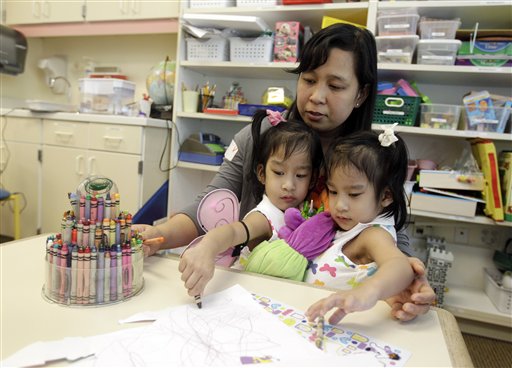
Angelica Sabuco, 2 (right), and her twin sister Angelina (left), draw on paper with the help of their mother Ginady Sabuco (center), at the Lucile Packard Children's Hospital, Monday, Oct. 31, 2011 in Stanford, California. The Stanford hospital is preparing for surgical procedure to separate the two-year old girls, who were born joined at the chest and abdomen. (AP Photo/Marcio Jose Sanchez)
PALO ALTO, California—Two-year-old twin girls who are joined at the chest and abdomen were undergoing final preparations on Monday for a complex surgery at a California hospital that is meant to separate them.
Doctors at Stanford University’s Lucile Packard Children’s Hospital are planning a nine-hour procedure on Tuesday that, if successful, will allow Angelica and Angelina Sabuco to live independently from each other.
The girls were born in the Philippines and live in California with their family.
Pediatric surgeon Gary Hartman, who has performed five similar procedures, said he expected the twins to survive and do well. The operation will involve more than 20 physicians and nurses from various specialties, and it culminates several months of planning.
“I want them to live normally, like other children,” Ginady Sabuco, the girls’ mother, said in a statement from the hospital.
The girls have done well so far. They love listening to stories and music, and they know their colors and can count to 10. They celebrated their second birthdays with cakes adorned with Disney princesses and Tinker Bell.
But remaining conjoined carries risks for the girls’ health, especially if they share organs unequally. If one conjoined twin dies, the other will die within hours.
Severing liver riskiest
The girls’ livers, diaphragms, breast bones, chest and abdominal wall muscles are fused. They have separate hearts, brains, kidneys, stomachs and intestines.
The occurrence of conjoined twins is estimated to range from 1 in 50,000 births to 1 in 100,000 births worldwide, and the overall survival rate is approximately 25 percent, according to the hospital.
The operation will involve cutting along the girls’ skin and muscle and separating their diaphragms and livers. Hartman said severing the liver will be the riskiest part of the procedure because of potential blood loss.
Doctors will then cut any adhesions between the girls’ bowels and snip any remaining skin. Separate reconstruction operations will follow.
The girls are expected to be hospitalized for nearly two weeks.
Hartman said he doesn’t expect the children will need intense physical therapy following surgery but they may experience regression with some milestones they’ve already hit. The girls can walk now despite their face-to-face orientation but may lose that ability, for example, for a few weeks to months while they recover.
Separation anxiety
“We expect they will have a little separation anxiety, too,” said Ruby Sabuco-Collins, the girls’ aunt. “But we’re just so proud of them now and so excited for them in the future.”
Ginady said she learned her babies were conjoined when she was seven months pregnant and her husband was working in San Jose, California.
The babies were born in August 2009, and she joined her husband, Fidel, in California in late 2010 when they began meeting with doctors at Packard Children’s Hospital. Reports from AP and AFP
Originally posted: 11:38 am | Tuesday, November 1st, 2011

